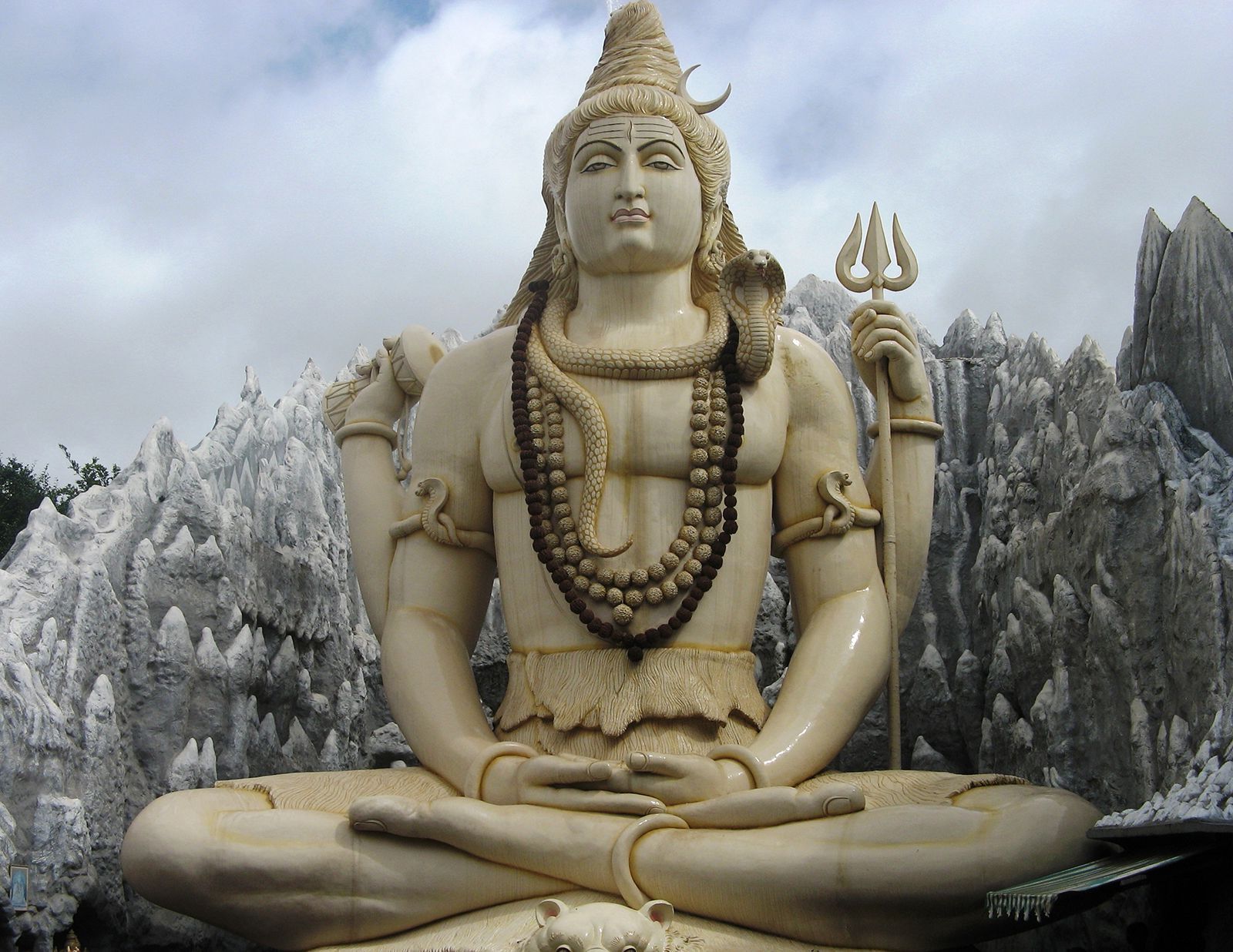
Who is Shiva? Shiva, one of Hinduism's principal deities, embodies both destruction and regeneration. Known as Mahadeva, or "the Great God," Shiva's influence spans thousands of years and numerous aspects of life. He forms the Trimurti with Brahma and Vishnu, representing creation, preservation, and destruction. Shiva's many forms, like Nataraja the cosmic dancer and Ardhanarishvara the androgynous union, highlight his complex nature. His consorts, Parvati, Durga, and Kali, symbolize feminine power, while his children, Ganesha and Kartikeya, represent wisdom and war. Shiva's paradoxical nature, combining asceticism and fertility, makes him a fascinating figure in Hindu mythology.
Key Takeaways:
- Shiva, the Hindu deity, has many names and forms, representing both destructive and regenerative powers. His family, abode, and symbols reflect his multifaceted nature and diverse roles in Hindu mythology.
- Shiva's worship includes diverse practices and symbols, such as the lingam, yoga, and Naga worship. Devotees use sacred symbols and rituals to seek Shiva's blessings and protection, honoring his multifaceted nature.
The Many Names and Epithets of Shiva
Shiva, one of the principal deities in Hinduism, is known by numerous names and epithets that reflect his diverse nature and attributes.
- Shiva: His name means "the auspicious one," highlighting his benevolent nature.
- Mahadeva: Translates to "the Great God," emphasizing his supreme status.
- Mahesha: Means "the Great Lord," another title of reverence.
- Shankara: Known as "the Beneficent," showcasing his kind and protective aspects.
Shiva and the Trimurti
Shiva is part of the Trimurti, a trio of gods that represent the cosmic functions of creation, preservation, and destruction.
- Trimurti: Shiva, along with Brahma and Vishnu, forms the Trimurti, symbolizing the cyclical nature of the universe.
- Brahma: The creator god in the Trimurti.
- Vishnu: The preserver god in the Trimurti.
- Shiva: The destroyer and regenerator, completing the cycle.
Diverse Forms of Shiva
Shiva is depicted in various forms, each representing different aspects of his nature.
- Nataraja: The cosmic dancer, symbolizing the cycle of life and death.
- Ardhanarishvara: The androgynous form, combining Shiva and Parvati, representing the unity of male and female energies.
- Bhairava: A fierce protector, often shown with a dog.
- Lingam: A cylindrical object symbolizing fertility and spiritual growth.
Shiva's Family
Shiva's family includes his consorts and children, each with their own significance.
- Parvati: His primary consort, representing love and fertility.
- Durga: Another form of his consort, symbolizing strength and protection.
- Kali: A fierce aspect of his consort, representing destruction of evil.
- Ganesha: His elephant-headed son, the god of wisdom.
- Kartikeya: His son, the god of war.
Mount Kailasa: Shiva's Abode
Shiva's mythical home is Mount Kailasa, a sacred site in Hindu mythology.
- Mount Kailasa: Located in the Himalayas, it is considered the abode of Shiva and Parvati.
- Sacred Site: Revered by Hindus, Buddhists, Jains, and Bonpos.
Shiva's Vehicle and Attributes
Shiva is often depicted with various symbols and attributes that highlight his powers and roles.
- Nandi: His vehicle, a bull, symbolizing strength and virility.
- Third Eye: Represents inner wisdom and destructive power.
- Blue Throat: Result of drinking poison to save the world.
- Serpent King Vasuki: Worn around his neck, symbolizing control over fear and death.
- Crescent Moon: Adorning his head, symbolizing time and its cycles.
- Holy River Ganga: Flowing from his matted hair, representing purification.
- Trishula (Trident): His weapon, symbolizing his power to destroy evil.
- Damaru: A small hand drum, symbolizing creation and destruction.
The Paradoxical Nature of Shiva
Shiva embodies both destructive and regenerative powers, making him a complex deity.
- Destruction and Regeneration: Represents the cyclical nature of life and death.
- Asceticism and Fertility: Balances a life of renunciation with aspects of fertility and creation.
Shiva and Yoga
Shiva is revered as the first yogi, the originator of yoga and meditation practices.
- Adiyogi: Known as the first yogi, introducing yoga to humanity.
- Meditation: Often depicted in a meditative pose, symbolizing spiritual enlightenment.
Fierce and Benevolent Aspects
Shiva's fierce and benevolent aspects highlight his role as both a protector and destroyer.
- Fierce Protector: Depicted slaying demons, showcasing his role in destroying evil.
- Benevolent Yogi: Shown as an ascetic, living a life of meditation and peace.
Mythological Origins and Evolution
Shiva's origins are rooted in ancient traditions, evolving over time through various cultural influences.
- Pre-Vedic Traditions: Originated from tribal traditions before the Vedic period.
- Rudra: Mentioned in Vedic texts as a fierce god associated with storms.
Shaivism: The Worship of Shiva
Shaivism is a major sect of Hinduism that venerates Shiva as the supreme god.
- Shaivism: One of the oldest sects, predating the Vedic period.
- Geographical Spread: Found in various parts of India and Southeast Asia.
Worship Practices and Symbols
Shiva worship includes diverse practices and symbols that reflect his multifaceted nature.
- Lingam Worship: Represents Shiva's phallus, symbolizing fertility and spiritual growth.
- Yoga and Meditation: Practices aimed at achieving spiritual enlightenment.
- Naga Worship: Worship of snakes, associated with Shiva's power.
Sacred Symbols and Rituals
Devotees use various symbols and rituals to seek Shiva's blessings and protection.
- Rudraksha Mala: Beads worn by devotees, believed to be blessed by Shiva.
- Nandi Ji: The bull, often depicted in front of Shiva temples.
- Tiger Skin Mattress: Symbolizes his victory over animal instincts.
- Ashes (Bhasm): Covering his body, reminding devotees of life's impermanence.
Avatars and Legends
Shiva's avatars and legends highlight his diverse roles and attributes in Hindu mythology.
- 19 Avatars: According to the Shiva Purana, representing different aspects of his nature.
- 28 Avatars: Mentioned in the Kurma Purana, showcasing his various roles.
Iconography and Attributes
Shiva's iconography includes various attributes that symbolize his powers and roles.
- Serpent King Vasuki: Around his neck, symbolizing control over fear.
- Crescent Moon: On his head, representing time and its cycles.
- Holy River Ganga: Flowing from his hair, symbolizing purification.
- Trishula and Damaru: His weapon and drum, representing his power to create and destroy.
Shiva's Enduring Influence
Shiva's multifaceted nature makes him one of Hinduism's most intriguing deities. Known as the God of Destruction and Regeneration, he embodies both the end and the beginning of all things. From his third eye symbolizing inner wisdom to his blue throat from drinking poison to save the world, Shiva's attributes are rich with symbolism. His forms, like Nataraja and Ardhanarishvara, highlight the balance of life and death, male and female energies. Worship practices, including lingam worship and yoga, show his deep influence on spiritual life. Shiva's legacy, spanning thousands of years, continues to inspire devotion and cultural practices. Whether seen as a fierce protector or a benevolent yogi, Shiva's presence in Hindu mythology and culture remains profound. His paradoxical nature, combining destruction and regeneration, ensures his enduring significance in the hearts of devotees.
Frequently Asked Questions
Was this page helpful?
Our commitment to delivering trustworthy and engaging content is at the heart of what we do. Each fact on our site is contributed by real users like you, bringing a wealth of diverse insights and information. To ensure the highest standards of accuracy and reliability, our dedicated editors meticulously review each submission. This process guarantees that the facts we share are not only fascinating but also credible. Trust in our commitment to quality and authenticity as you explore and learn with us.


